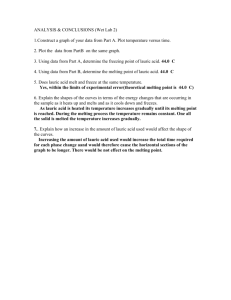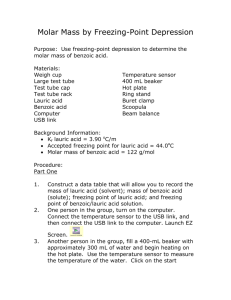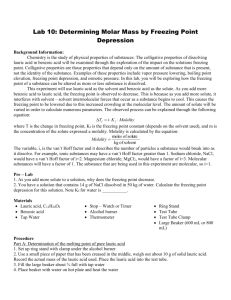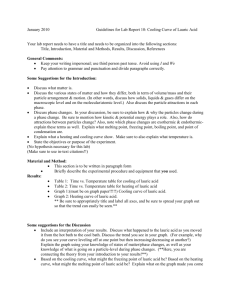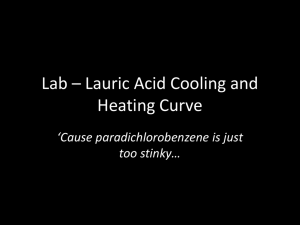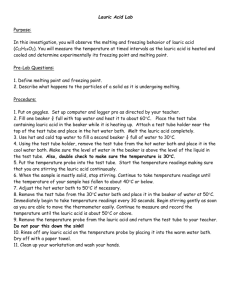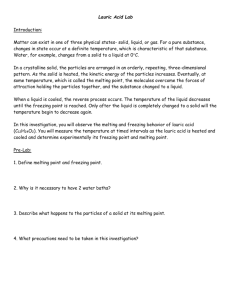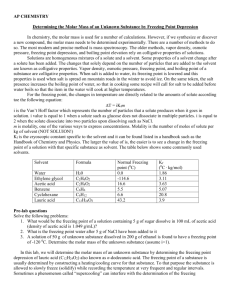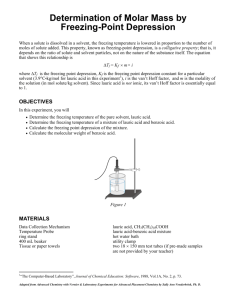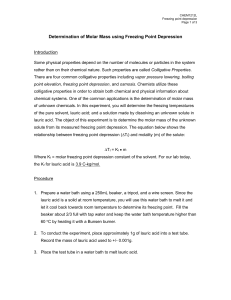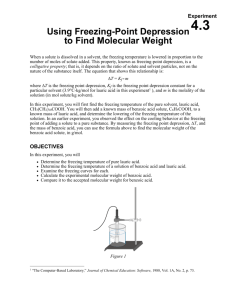Lab 07 Determining Molar Mass by Freezing Point Depression
advertisement
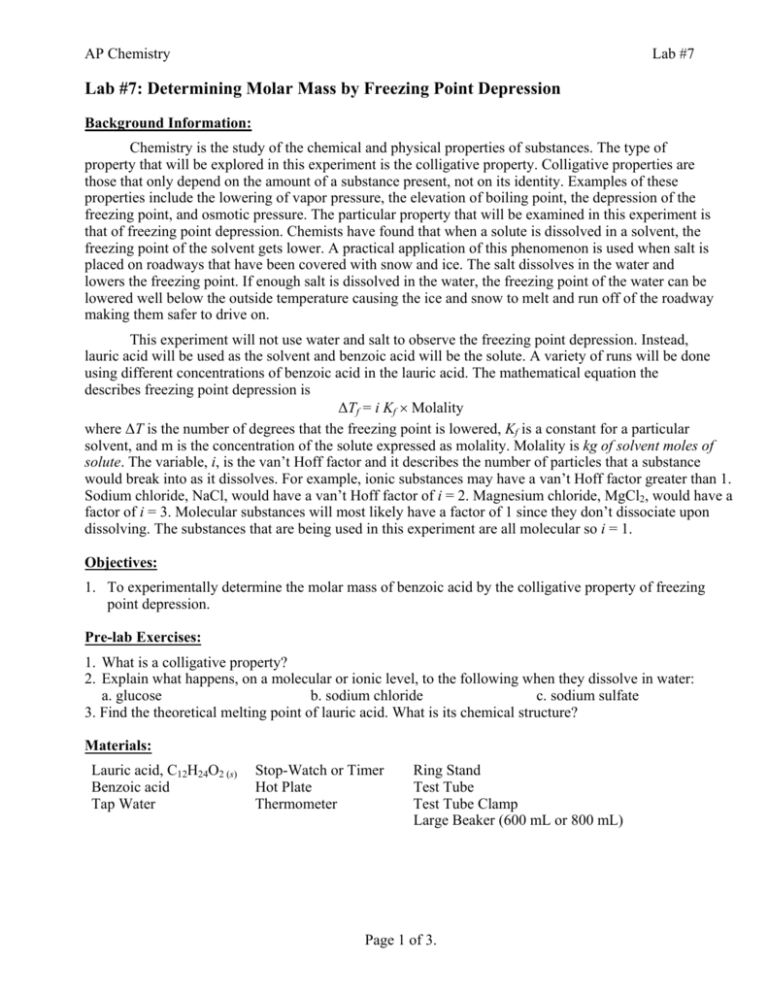
AP Chemistry Lab #7 Lab #7: Determining Molar Mass by Freezing Point Depression Background Information: Chemistry is the study of the chemical and physical properties of substances. The type of property that will be explored in this experiment is the colligative property. Colligative properties are those that only depend on the amount of a substance present, not on its identity. Examples of these properties include the lowering of vapor pressure, the elevation of boiling point, the depression of the freezing point, and osmotic pressure. The particular property that will be examined in this experiment is that of freezing point depression. Chemists have found that when a solute is dissolved in a solvent, the freezing point of the solvent gets lower. A practical application of this phenomenon is used when salt is placed on roadways that have been covered with snow and ice. The salt dissolves in the water and lowers the freezing point. If enough salt is dissolved in the water, the freezing point of the water can be lowered well below the outside temperature causing the ice and snow to melt and run off of the roadway making them safer to drive on. This experiment will not use water and salt to observe the freezing point depression. Instead, lauric acid will be used as the solvent and benzoic acid will be the solute. A variety of runs will be done using different concentrations of benzoic acid in the lauric acid. The mathematical equation the describes freezing point depression is ΔTf = i Kf × Molality where ΔT is the number of degrees that the freezing point is lowered, Kf is a constant for a particular solvent, and m is the concentration of the solute expressed as molality. Molality is kg of solvent moles of solute. The variable, i, is the van’t Hoff factor and it describes the number of particles that a substance would break into as it dissolves. For example, ionic substances may have a van’t Hoff factor greater than 1. Sodium chloride, NaCl, would have a van’t Hoff factor of i = 2. Magnesium chloride, MgCl2, would have a factor of i = 3. Molecular substances will most likely have a factor of 1 since they don’t dissociate upon dissolving. The substances that are being used in this experiment are all molecular so i = 1. Objectives: 1. To experimentally determine the molar mass of benzoic acid by the colligative property of freezing point depression. Pre-lab Exercises: 1. What is a colligative property? 2. Explain what happens, on a molecular or ionic level, to the following when they dissolve in water: a. glucose b. sodium chloride c. sodium sulfate 3. Find the theoretical melting point of lauric acid. What is its chemical structure? Materials: Lauric acid, C12H24O2 (s) Benzoic acid Tap Water Stop-Watch or Timer Hot Plate Thermometer Ring Stand Test Tube Test Tube Clamp Large Beaker (600 mL or 800 mL) Page 1 of 3. AP Chemistry Lab #7 Procedure: Part A: Determination of the melting point of pure lauric acid. 1. Set up ring stand and test tube clamp beside the hot plate. 2. Use a small piece of paper that has been creased in the middle, weigh out about 10 g of solid lauric acid. Record the actual mass of the lauric acid used. Place the lauric acid into the test tube. 3. Fill the large beaker about ¾ full with tap water. 4. Place beaker with water on hot plate and start heating water. 5. Place test tube in beaker and heat until the lauric acid is completely melted (be sure to stir the lauric acid carefully with the thermometer). 6. Once the lauric acid is completely melted, carefully remove the lauric acid from the hot water and allow it to cool. Keep the beaker of water warm for later trials. 7. Record the temperature every 30 seconds until the temperature reaches approximately 35°C. Part B: Determination of the freezing point of lauric acid/benzoic acid mixture 8. Use a small piece of paper that has been creased in the middle, weigh out about 1.0 g of benzoic acid and place into the test tube with the lauric acid. Record the actual mass of the benzoic acid used. 9. Using the hot water from the trial with pure lauric acid, place test tube in beaker and heat until the lauric acid/benzoic acid mixture is completely melted. (Be sure to stir the lauric acid carefully with the thermometer.) 10. Once the mixture is completely melted, carefully remove it from the hot water and allow it to cool. 11. Record the temperature every 30 seconds until the temperature reaches approximately 25°C. 12. Repeat steps 8 through 11 two more times increasing the amount benzoic acid by about 1.0 g each time. Record the total mass of benzoic acid used with each trial. Observations: (This table can be extended if needed.) Time Trial 1 (____ g lauric acid) Trial 2 (____ g lauric acid + ______ g benzoic acid) Trial 3 (___ g lauric acid + _____ g benzoic acid) 0:30 1:00 1:30 2:00 2:30 3:00 3:30 4:00 4:30 5:00 5:30 6:00 6:30 7:00 7:30 Page 2 of 3. Trial 4 (_____ g lauric acid + _____ g benzoic acid) AP Chemistry Lab #7 Analysis: 1. Graph the temperature data with temperature on the y-axis and time on the x-axis. If done carefully, all three sets of data can be plotted on the same graph in different colors. Label all axis and scales. Provide a legend and a title. 2. Determine the freezing point for each trial from the graph. Label them on the graph. 3. Determine the ΔTf for each trial. 4. The Kf for lauric acid is 3.90 °C • kg /mol. Use this information, along with the data that has been accumulated in this lab to calculate the molality of each solution (Trial 2 to 4). 5. Using the molality equation and the rest of the data collected during this lab, calculate the molar mass of benzoic acid from each trial and average the best trials. Evaluation: 1. State the chemical formula of benzoic acid. Determine its theoretical molar mass. 2. Calculate the molar mass percent error using the average experimental value determined for benzoic acid. 3. In the pre-lab exercise, the theoretical melting point of lauric acid was found. Determine the % error of your experimental lauric acid melting point. Does this error affect the molar mass determination of benzoic acid? Explain. 4. Describe two sources of error and how they affected your experimental molar mass. 5. Do you think the same experimental technique could be used to determine the molar mass of any solids? Explain your answer. Conclusion: Summarize what you have learned from this lab. Page 3 of 3.
